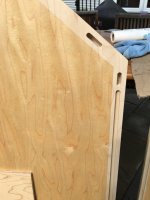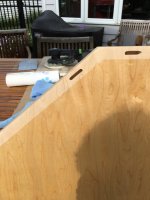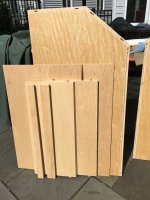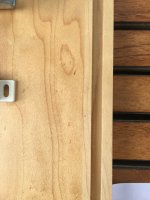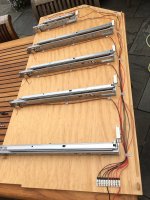Steven Owen said:
Steven Owen said:
I find it interesting you would consider using a random orbital on sheet plywood. Most people reccomend orbital sheet sanders for the job. My biggest concern with using a random orbital on such a thin veneer would be a higher potential for swirl marks even with a light touch.
I was thinking more about human error when sanding veneers. The rectangular shape of larger sheet sanders force you to stay with the grain when sanding.
Large 1/2 sheet sanders are great for keeping a large surface flat when you have a lot of resawing/planer marks to remove. However, when the surface is already flat they really don't offer any additional magic that any 125/150 sized ETS EC type sander can provide. Using fine grit papers, the dwell time over any specific spot is really minimal because the area is already flat and the surface is already relatively smooth. The veneered ply you're purchasing doesn't have a 40-80 grit surface finish, if it did you probably wouldn't purchase it in the first place.
Per the random orbital swirl mark observation, a random orbital sander in woodworking vernacular, is also known as a DA (dual action) sander in the automotive finish trade. I purchased my first pneumatic, National Detroit DA version in the late 60's or early 70's and still own it. The DA sander has been the go to sander for the automotive/motorcycle paint restoration business for the last 50+ years. As far as I know it may still be...unless laser surface treatment techniques suddenly became more popular when I walked away from the computer and took the dog for a walk. If so...that'd be cool. [cool]
What other, more highly defined surface, is offered to the general public than the painted surface of a new automobile? Be it a Suburu or a Mercedes, what surface is smoother, has virtually no orange peel and exhibits no swirl marks than a new automobile? These surfaces were probably prepped using DA sanders.
In wood working semantics we refer to them as "piano finishes" or "polished lacquer" finishes, when in reality we are really trying to replicate automotive type finishes on wooden materials. [tongue] And we are using random orbital sanders to produce that finish.
Whoops...I forgot to include these photos. Maple ply, purchased from the cheapest-of-the-cheap big boxes, Menards. Sanded with a ETS EC 125 wearing a 150 sized pad, using 240 Granat and finished with 3 coats of GF water based clear poly, hand sanded between coats with Festool 400 grit foam backed squares.

